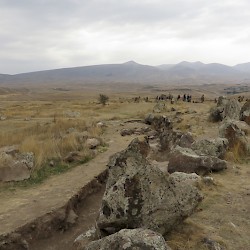Karahunj
Q2479712Karahunj: megalithic sanctuary in Armenia, also known as Dik-dik Karer, Koşun taş, and Zorats Karer.

Standing splendidly isolated in a devastatingly empty landscape, surrounded by snowclad mountains, the megalithic complex of Karahunj, also known as Zorats Karer, in Armenia is quite impressive. Yet it is not big at all: it consists of little more than a low burial mound of flat gray stones, surrounded by a circle of forty menhirs, each about two meters high. From here, two lines of upright stones extend to the north and south. In the far north and in the far south, there are some additional stones.
In total there are 222 or 223 chunks of basalt. In eighty-four of them, holes have been drilled, which can create a whistling sound when the wind is blowing over the plain. This explains the name Karahunj, “the speaking stones”.
Observatory?

It has been assumed that Karahunj is an ancient observatory. This theory has the merit that it is always true. Because there are eighty-four pierced stones, pointing in 168 directions, and because there is a gradual shift in the rotation of the axis of the earth (the precession of the equinoxes), some hole can always be found that has in one age or another pointed in a meaningful direction, like the place where the sun (Sirius, Pleiades…) rises on the longest or shortest day of the year. Or on the first day of spring or autumn.

Moreover: Karahunj is in Armenia, a region with many earthquakes and the megalithic monument lies atop the fault line on which the notorious earthquake of 1988 took place. A quake in 1407 had its epicenter pretty much right under Karahunj. It is not likely that the stones are still standing in their original position – in fact half of the pierced stones have fallen over.
More speculation

In short, the hypothesis that Karahunj is an ancient observatory cannot be tested, but this has not prevented speculation. The site is traditionally called Dik-dik Karer, which means something like “upright stones”, and Koşun taş, which is Turkish for “stone army”. Because the last-mentioned language is not really popular in Armenia, this name was translated into Armenian: Zorats Karer. The Armenian researcher Elma Parsamian has introduced the name Karahunj, “speaking stones”, loosely based on a medieval village named Karunj in this neighborhood. This fabricated name was used to goropize that Stonehenge in England was inspired by the Armenian monument: it was derived Stone Hunj.
Archaeological Investigations

Of course you can also dig up the site. So far, thirty graves have been identified, the oldest of them dating to the Middle Bronze Age (between 2000 and 1600 BCE), and the most recent to the tenth century BCE. The burial mound covered with flat gray stones that is surrounded by forty menhirs dates back to the beginning of the first millennium BCE.
In the Hellenistic period, Karahunj served as a refuge castle and the two lines of stones that stretch from the north to the south have turned out to be the base of a city wall.











